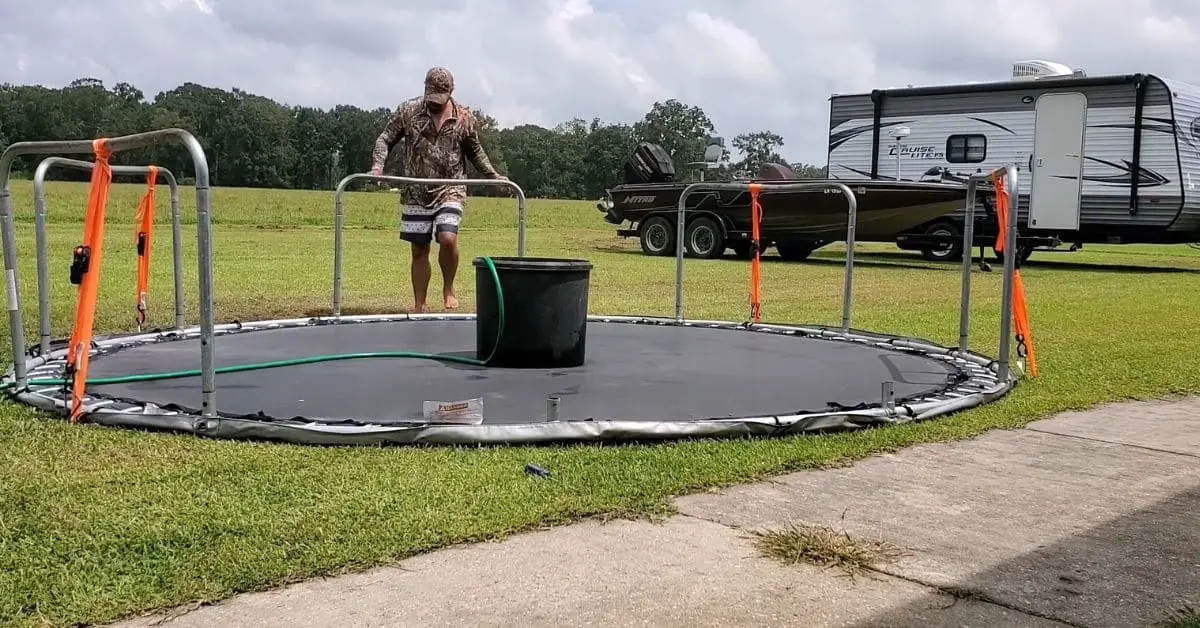If you are worried about how to secure a trampoline in a hurricane? Ensuring trampoline hurricane safety is crucial if you reside in a hurricane-prone area. Firstly, check the weather forecast to determine if a hurricane is coming. Inspect the trampoline for any damages, then find the safest location for it during a hurricane.
If disassembly is feasible, remove and store it in a secure place such as a garage. If not, detach the netting, mat, and other parts, and anchor the frame to the ground. Cover the trampoline with a heavy-duty tarp and fasten it tightly.
If it cannot be moved, use heavy items like sandbags to weigh it down and prevent it from being blown away. After the hurricane has passed, inspect and clean the trampoline before reassembling it.
Always supervise children and follow manufacturer’s guidelines for a safe and secure trampoline.
How to Secure a Trampoline in a Hurricane: Secure your trampoline during a hurricane by checking the weather forecast, inspecting for damage, disassembling or securing it to the ground, and weighing it down with sandbags or heavy objects.
How to prevent a trampoline from blowing away?
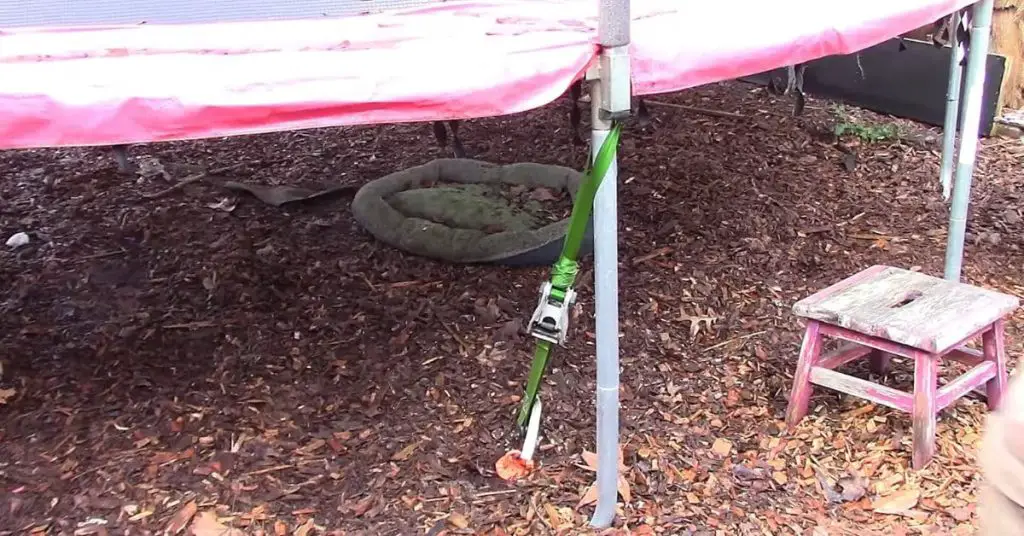
If you want to secure your trampoline for a storm or hurricane, placing it in a part of your yard that is protected from the wind is best. This may not always be possible, but if you can find a small area that is sheltered, that will help.
You could use a fence, shed, barn, or line of trees as a windbreak. This will reduce the chances of your trampoline being blown away or damaged during a storm.
If you have enough time before a storm, you can use wind stakes, trampoline anchors, or sandbags to keep your trampoline from blowing away.
But if there isn’t enough time, you can remove the safety net, springs, and mat so that only the frame is left, which is less likely to be blown away.
At what wind speed can a trampoline be lifted?
Have you ever seen pictures of trampolines that have been blown away by strong winds and ended up in strange places? It’s good to know that a wind speed of around 35-40 miles per hour can cause a trampoline to move a few feet.
A wind speed of 50-60 miles per hour can lift the trampoline up and send it rolling to the side. And if there’s a powerful gust of wind over 60 miles per hour, the trampoline can fly into the air.
This can depend on how open the yard is, what natural windbreaks you have, and how strong and steady the wind is.
What are the Consequences of a trampoline blowing away?
When a trampoline gets blown away, it can be carried away by the wind and end up several feet away from your yard or even further. If your trampoline gets carried away, it’s important to locate it and see if it caused damage to other people’s property, such as a car, house, or fence.
If your trampoline caused any damage, you may be asked to fix it by the affected party. If your trampoline ends up stuck in power lines, do not touch the metal frame of the trampoline. It’s important to call the utility company to report the issue and have them remove the trampoline.
Even if the power is down in your area, it’s not worth risking your safety to try and remove the trampoline yourself. Wait for the professionals to take care of it.
It’s also important to note that trampolines can be dangerous during a storm or hurricane. If you live in an area prone to severe weather conditions, it’s best to take precautions beforehand to secure your trampoline.
This includes disassembling the trampoline and storing it in a secure location like a garage or shed or using wind stakes, trampoline anchors, or sandbags to weigh it down. Taking these steps can prevent your trampoline from causing any damage during a storm or hurricane.
Can the type of trampoline affect its susceptibility to being blown away in strong winds?
The type of trampoline you have affects how easily it can be blown away. Inground trampolines are less likely to be blown away as the pit anchors the legs.
Cheaper above-ground trampolines made of thinner steel tubes are lighter and can be lifted by the wind, while heavier and more expensive ones are harder to lift and more secure.
When it comes to trampoline size, the difference in wind resistance between small and large trampolines is not significant. Smaller trampolines may be lighter but have a smaller mat that acts as a sail. Larger trampolines have a larger sail area that can catch the wind and send the trampoline flying.
Additionally, having a safety net can increase the chances of the trampoline blowing away. This is because the safety net can catch the wind and act as a sail, making it more likely for the trampoline to be lifted.
Does Insurance cover wind damage to a trampoline?
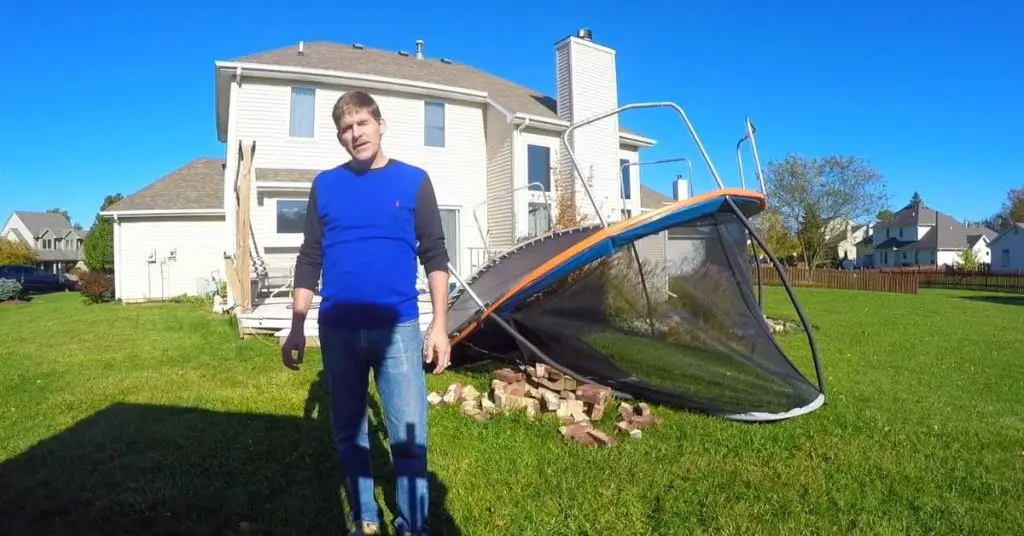
Whether insurance will cover damage to your trampoline caused by wind depends on your individual insurance policy. In many cases, trampolines are not covered by homeowners’ insurance policies.
However, if you have a secure yard and can demonstrate that you have taken steps to tie down the trampoline in case of wind, you may be able to negotiate insurance cover for it.
Keep in mind that you will need to do this before any wind damage occurs, and you may need to shop around for an insurance provider that offers this cover.
What is the recommendation for anchoring a trampoline?
Anchoring your trampoline is recommended when there are strong winds (above 25-30mph) to prevent it from being blown away. This is important for ensuring the safety of your trampoline and preventing any damage caused by a storm.
By securing your trampoline with appropriate measures, such as using anchors and tie-downs, you can help protect it during severe weather conditions.
How to Secure a Trampoline in a Hurricane? Some Ways
There are a few ways to keep your backyard trampoline from getting blown away in the wind, whether it’s from a cyclone, storm, or hurricane.
Corkscrew Anchors for Trampoline Security:
Corkscrew anchors, also known as augers, are the best way to secure a trampoline in most soil types during high winds, including hurricanes. They are most effective if they are at least 16 to 20 inches long, and you will need four of them for an average trampoline.
However, they do not work well in sandy soil. The anchors cannot easily lift out of the soil, which makes them a reliable option.
Corkscrew anchors, also known as augers, are a type of anchor that works similarly to screws. Just like a screw is difficult to lift out of a surface once it has been screwed in, a corkscrew anchor creates a channel that is hard to lift. This makes it an effective way to secure your trampoline in high winds, even during hurricanes.
One of the advantages of corkscrew anchors is that wind can’t unscrew them. This means that the anchor will stay in place even during the strongest winds, preventing your trampoline from being blown away.
Another advantage is that good-quality corkscrew anchors come with tie-down straps. These straps can be attached to the top of the trampoline frame and hold it securely in place.
This is important because if the top of the trampoline comes off the base of the legs, the trampoline can become unstable and potentially dangerous.
It’s important to note that corkscrew anchors work best in most soil types, but not in sand, as the anchors can simply lift out. To ensure the best protection for your trampoline, it’s recommended to use corkscrew anchors that are at least 16-20 inches long. You will typically need a pack of 4 for an average-sized trampoline.
Using Sandbags to Secure Your Trampoline:
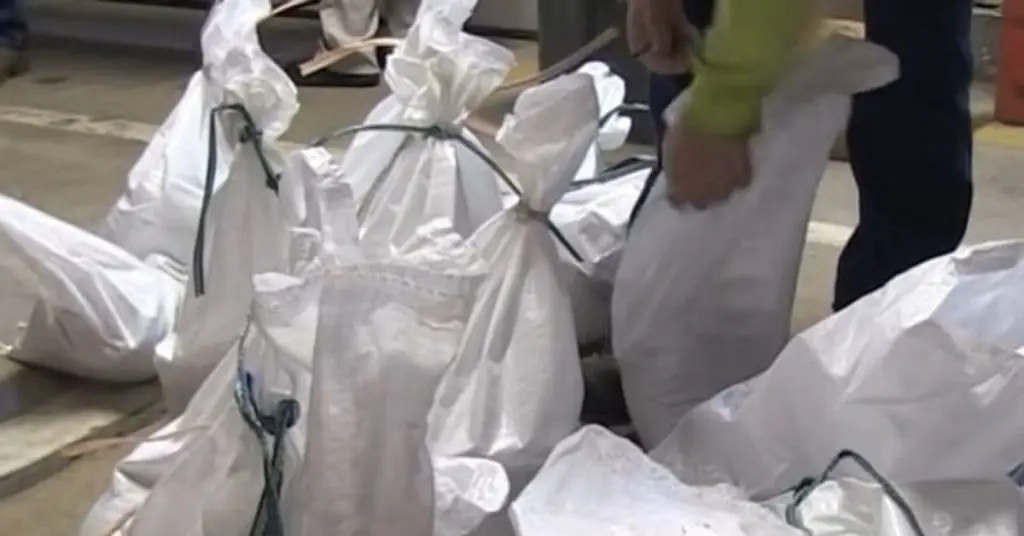
Sandbags are a simple and effective way to secure a trampoline during high winds. They can be used alone or in conjunction with other types of anchors. The main advantage of using sandbags is that they add weight to the base of the trampoline, making it harder for wind to lift it off the ground.
A typical sandbag weighs between 35-40 pounds, which is a significant amount of weight to add to the base of a trampoline. This means that wind speeds need to be significantly higher to have any chance of blowing the trampoline away.
However, it’s important to note that even with sandbags, strong winds can still lift the trampoline mat and cause damage to the top of the trampoline. If the bolts holding the top of the trampoline are loose or starting to wear out, they can also snap off and cause the top of the trampoline to fly away.
To prevent this, it’s a good idea to tie down the frame of the trampoline to the base using straps or other tie-downs. This will ensure that the top of the trampoline remains securely attached to the base, even during the strongest winds.
Overall, sandbags are a great addition to any trampoline anchoring system, but they should be used in combination with other methods to ensure the safety and stability of the trampoline.
Removing the Trampoline:
To prevent a trampoline from being blown away, it’s important to make sure it’s not left loosely in the yard. If you have a barn or storage space, you can put it there to keep it safe. But if you live in an area prone to strong winds or cyclones, it’s better to take the trampoline down.
For instance, if you’re expecting winds above 60 mph or if the anchors are put into sandy soil, it’s highly recommended to take it down. You should avoid storing the trampoline sideways in the yard, as it can easily blow around and cause damage.
However, taking the trampoline down or moving it around every time there’s a wind can be a big task, especially if you’re not at home or on vacation. In this case, it’s best to explore more permanent solutions like anchoring.
This can help keep your trampoline in place during high winds or storms. While taking down the trampoline can be a bit of a hassle, it’s a small price to pay for the safety of your family and the protection of your property.
Anchoring with U-Shaped Anchors:
U-shaped anchors, also known as wind stakes, are a popular type of trampoline anchor that can help keep your trampoline from being blown away in moderate winds. They are designed to fit over the base of the trampoline legs and are simply pushed into the ground.
The advantage of using U-shaped anchors is that they are relatively inexpensive and easy to install. They can also help prevent kids from bouncing the trampoline around the yard.
However, it is important to note that U-shaped anchors may not be suitable for areas with strong winds, storms, or hurricanes. These types of anchors are better suited for light to moderate wind environments.
In areas with serious wind conditions, U-shaped anchors may not be strong enough to hold the trampoline in place. It is recommended to use a more heavy-duty anchor in these situations.
Additionally, the effectiveness of U-shaped anchors can also depend on the type of soil they are anchored into. If the soil is too loose or sandy, the anchors may not be able to hold the trampoline in place.
Overall, U-shaped anchors can be a simple and inexpensive solution for securing your trampoline in moderate wind conditions. However, it is important to assess your specific location and wind conditions before deciding which type of anchor to use.
Secure the Trampoline:
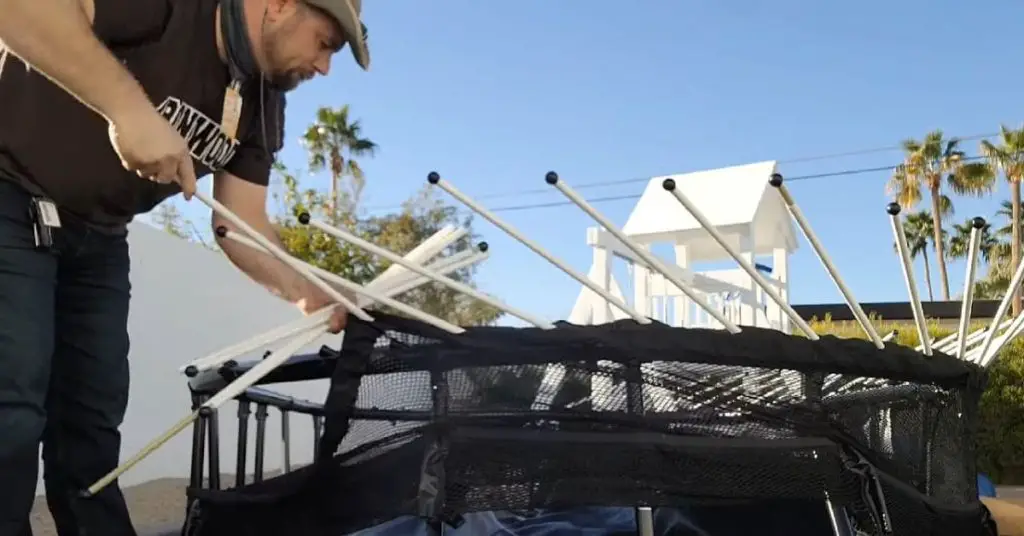
How to secure a trampoline in a hurricane. Here are some tips:
- Use a trampoline cover: A cover can protect the trampoline from harsh weather conditions such as rain, snow, and sun. It can also keep debris and dirt off the mat, which can help it last longer.
- Regularly check for damage: Check the trampoline regularly for any damage, such as tears in the mat or rust on the frame. Repair or replace any damaged parts as soon as possible to prevent further damage and ensure the safety of anyone using the trampoline.
- Limit the number of users: Limit the number of people using the trampoline at once to reduce the risk of damage or accidents. Follow the manufacturer’s guidelines for weight limits and the number of users allowed.
- Remove shoes and sharp objects: Make sure anyone using the trampoline removes their shoes and any sharp objects from their pockets to prevent punctures and tears in the mat.
- Position the trampoline correctly: Position the trampoline on a level surface and away from any obstacles such as trees, fences, or walls. This can prevent damage from collisions and ensure the safety of users.
By following these tips, you can help protect your trampoline and ensure it lasts longer while keeping everyone safe while using it.
Trampoline On Deck: How To Secure It
When securing a trampoline on a deck, it’s important to consider the strength of the deck and the potential damage that anchors may cause. Anchors directly onto the decking may not be strong enough, and they can damage the deck in strong winds.
One solution is to use anchors in the soil underneath the deck and use long tie-down straps to connect the trampoline frame to the anchors. To do this, you’ll need to find a way to access the soil under the deck, such as removing some of the decking boards or using a special tool to dig holes.
Once you have the anchors in place, you’ll need to thread the tie-down straps through the gaps in the decking and connect them to the frame of the trampoline. Make sure to use at least four anchors and tie-down straps and tighten them securely.
You may also want to use a ratchet to ensure that the tie-down straps are tight enough to keep the trampoline in place during heavy winds.
Overall, securing a trampoline on a deck requires some careful planning and consideration of the strength of the deck and the potential damage that may be caused by anchors.
With the right anchors and tie-down straps, however, you can help keep your trampoline secure and prevent it from being blown away during strong winds.
What are some Ways to Secure a Trampoline on Concrete?
If you have to put your trampoline on concrete, you can still keep it safe from strong winds or storms. However, having a trampoline on concrete is not ideal because it can be hard for kids if they fall, and it doesn’t absorb the bounce well, which can make it move.
But if you don’t have any other option, we can find the best way to secure it.
Securing a Trampoline by Pouring Concrete:
If you’re pouring concrete for your trampoline, it’s best to add auger-style anchors into the concrete. These anchors should be 8″-12″ long and go in the center of each leg of the trampoline.
Use two pieces of Brickie’s string to measure where the anchors should go. Insert the anchors within 15 minutes of pouring the concrete.
Once the trampoline is in place, use ratchet straps to tie down the frame. The straps should go over the top of the frame near where the springs are, as well as around the bottom of the legs.
Securing a Trampoline on Already Poured Concrete:
If you already have a concrete slab where you want to place your trampoline, you can use rock climbing anchors to secure it. The recommended type of anchor for this job is the Petzel Coeur that resists being pulled perpendicular.
To install the anchors, use a power drill with a masonry drill bit to make a hole in the concrete. Once the hole is made, place the anchor in it and tighten the bolt to make it snug.
After the anchors are in place, secure the frame of the trampoline to them using tie-down ratchet straps. Make sure to tighten the straps properly so that the trampoline doesn’t move in heavy winds or storms.
By following these steps, you can safely and securely set up your trampoline on a concrete slab.
After the Hurricane
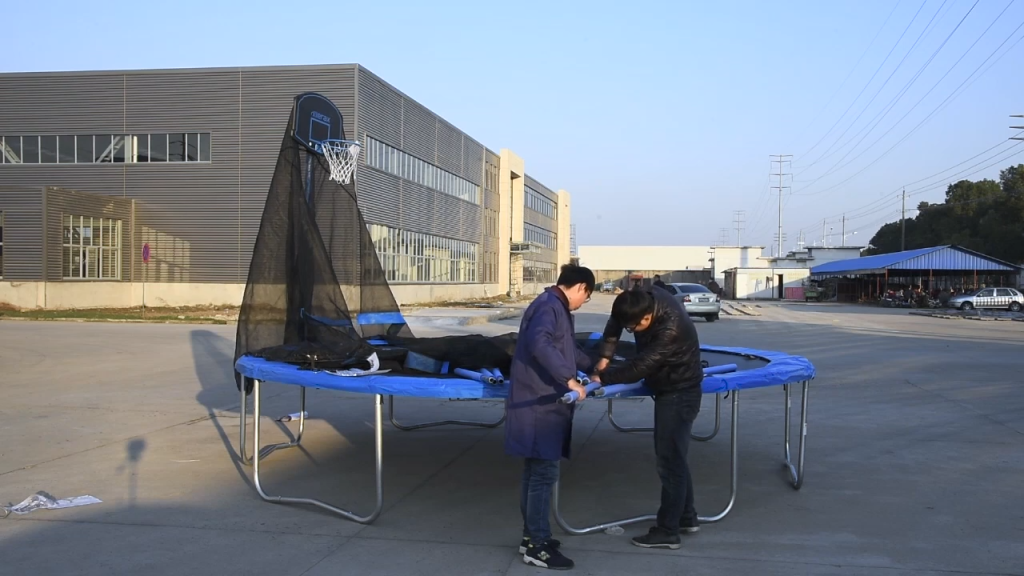
After a hurricane, it is important to inspect your trampoline for any damage before using it again. Check for any visible signs of damage, such as bent or broken metal frames, torn or stretched-out fabric, or missing parts.
If you notice any damage, it is important to replace those parts before using the trampoline again to ensure the safety of anyone using it.
Once you have inspected the trampoline and determined that it is safe to use, the next step is to clean and dry it thoroughly. Use a soft cloth and mild soap to clean the frame and fabric of the trampoline, paying special attention to any areas where dirt or debris may have accumulated. Allow the trampoline to dry completely before reassembling it.
Finally, before using the trampoline again, make sure to replace any damaged parts, such as springs or safety netting, to ensure that the trampoline is safe and secure. Follow the manufacturer’s instructions carefully when replacing parts to ensure that they are installed correctly and securely.
Only use replacement parts that are specifically designed for your trampoline to ensure the best fit and performance.
Other Safety Considerations
In addition to securing your trampoline during severe weather conditions, there are some other safety considerations to keep in mind.
Firstly, it’s important to follow all of the manufacturer’s guidelines for your specific trampoline model. This includes weight limits, age restrictions, and any other safety recommendations.
It’s also important to avoid using the trampoline during a hurricane or other severe weather conditions. Even if you have secured the trampoline, there is still a risk of injury due to high winds, falling debris, or flooding.
Finally, always supervise children while they are using the trampoline. Ensure that they are following safety guidelines, such as jumping in the center of the mat and avoiding flips and other dangerous maneuvers.
It’s also important to limit the number of people using the trampoline at one time and to ensure that only one person is jumping at a time.
rewrite in points
Storing the Trampoline
Here are some things to store the trampoline:
- If you live in a hurricane-prone area, consider storing the trampoline in a secure location during the off-season.
- Remove all detachable parts from the trampoline and store them properly to prevent damage.
- Cover the trampoline with a weatherproof cover to protect it from the elements while in storage.
- If possible, disassemble the trampoline for easier storage and transport. Make sure to keep all hardware and parts organized and labeled for reassembly.
Other Tips for Securing Outdoor Items
During a hurricane or severe weather conditions, it’s important to take steps to secure not only your trampoline but also other outdoor items that may become hazardous projectiles. Here are some tips for securing other outdoor items:
Bring in Lightweight Items:
Move any lightweight items indoors, such as patio furniture, lawn chairs, and potted plants. These items can become dangerous projectiles during high winds. If you don’t have space indoors to store them, consider tying them down or securing them to a solid structure.
Secure Heavy Items:
If you can’t move heavy items indoors, secure them to prevent them from being lifted or moved during a storm. Use sturdy tie-downs, cables, or chains to anchor heavy objects to the ground or to other immovable objects. For example, you can tie down your grill or anchor your shed to the ground.
Trim Trees:
Trees can become hazardous during high winds if their branches break or they uproot. Trim any branches that are close to your house or other structures, and consider removing trees that are in poor condition or located too close to your home. This can prevent damage to your property and reduce the risk of injury to you and your family.
Install Shutters:
Protect your windows and doors from flying debris by installing hurricane shutters or plywood covers. This can help prevent damage to your home and protect you and your family from injury.
Check your Insurance Coverage:
Make sure your homeowner’s insurance covers damage from hurricanes and other natural disasters. Consider adding additional coverage if necessary. This can help ensure that you have the financial resources you need to repair or replace any damage caused by the storm.
By following these tips, you can help keep your outdoor items safe during a hurricane or other severe weather conditions. Remember, it’s important to take all necessary precautions to protect yourself and your property from the potential dangers of a hurricane.
FAQs:
Q:1 Is it necessary to secure my trampoline during a hurricane?
Yes, it is important to secure your trampoline during a hurricane or severe weather conditions. A trampoline can easily become a dangerous projectile, causing damage to your property or injury to yourself or others if it is not properly secured.
Q:2 How can I secure my trampoline during a hurricane?
To secure your trampoline during a hurricane, you can use anchor kits or tie-down straps to attach it to the ground. You can also remove the netting and pad, deflate the trampoline, and store it in a safe location until the storm has passed.
Q:3 What type of anchor kit should I use to secure my trampoline during a hurricane?
It is recommended to use heavy-duty anchors designed specifically for trampolines, such as the Petzel Coeur rock climbing anchors. These anchors are designed to resist being pulled perpendicular and are suitable for use in concrete slabs.
Q:4 Can I use regular bungee cords or ropes to secure my trampoline during a hurricane?
No, regular bungee cords or ropes are not strong enough to secure a trampoline during a hurricane or severe weather conditions. You should use tie-down straps or anchor kits designed specifically for trampolines.
Q:5 Is it safe to use a trampoline after a hurricane?
No, you should inspect the trampoline for any damage and replace any damaged parts before using it again. You should also clean and dry the trampoline before reassembling it.
Q:6 Can I leave my trampoline assembled during the hurricane season?
It is recommended to disassemble and store your trampoline in a secure location during the off-season if you live in a hurricane-prone area. This can help prevent damage to your trampoline and ensure the safety of your property and others.
Q:7 Can I use my trampoline during a hurricane if it is properly secured?
No, it is not safe to use a trampoline during a hurricane or severe weather conditions, even if it is properly secured. High winds, falling debris, and flooding can still pose a risk of injury or damage to your property.
Conclusion:
In conclusion, securing your trampoline during a hurricane is crucial to preventing damage or injury. By following the steps outlined in this guide, you can ensure that your trampoline is properly secured and safe to use.
Start by checking your local weather forecasts and removing any loose items from your yard. Next, disassemble your trampoline and store it in a secure location, or use anchor kits to secure it to the ground.
When reassembling your trampoline after the storm, inspect it for any damage and replace any damaged parts before using it again.
Additionally, it’s important to follow all manufacturer guidelines for your specific trampoline model and supervise children while they are using the trampoline. Lastly, consider storing your trampoline in a secure location during the off-season and bring in any loose outdoor items during a storm.
Taking these precautions can help keep your family and property safe during hurricane season.
We hope you will be well aware of how to secure a trampoline in a hurricane after reading this comprehensive article. If you have any questions, feel free to comment below!

